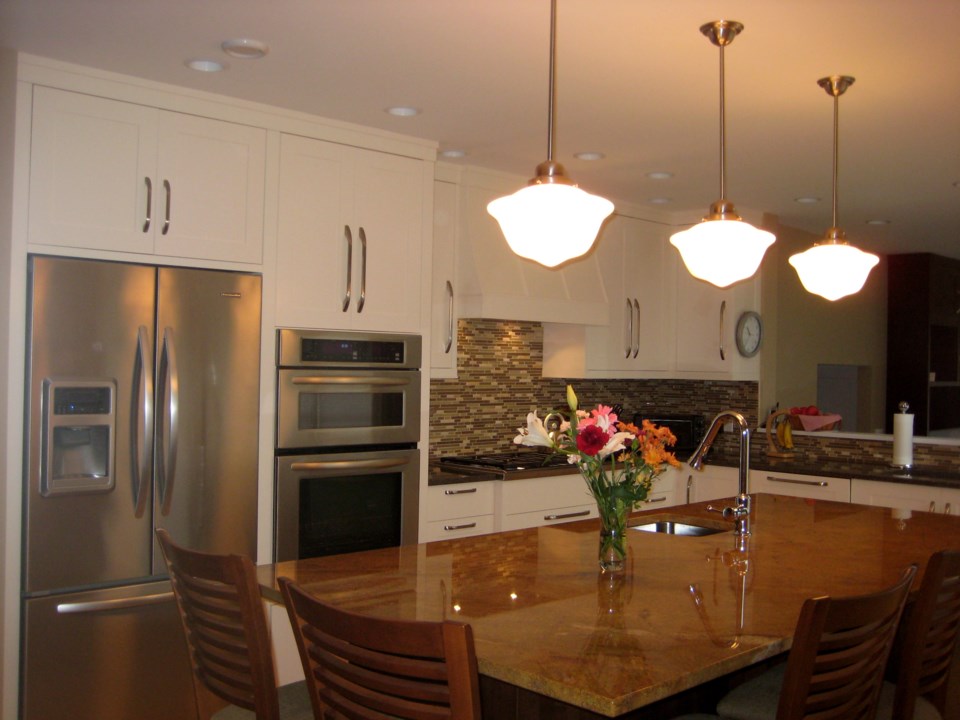(Please scroll to the bottom for more photos)
Unpleasant surprises resulted in unexpected expenses, but even that turned out to be a blessing in disguise
_____________________________________________
After six months that included a seemingly unending parade of decisions, some unpleasant surprises and frustrations, one less-than-reliable tradesperson, and a budget that ballooned with unexpected expenses, we finally moved back into our renovated home in late April.
Was it worth it -- all the hassles, the emotional strains, the considerable expenditures?
Yes, it was, in many ways.
It's been a two-year process. We moved out of our house a year ago so the renovation work could begin < and it was a full year before that that we first met with our designer to start making plans for the work.
During the project, we built great relationships with our contractor, Dave Rannala, and our designers at Zebra Group. Our tradespeople -- except for one challenging painter -- were professional, reliable and did a terrific job.
The final product looks as we imagined it.
And, after six months living within our "new walls," the house works as our designers promised it would.
Even the cause of our budget overrun turned out to be a blessing in disguise. Overall, the project came in about 30 per cent over our initial budget.
About two-thirds of that overrun can be attributed to the discovery, six weeks into the renovation, that water was starting to seep through the original 1946 foundation.
The solution required excavating around half the house to a depth of eight feet and refitting the foundation with a new drainage system and modern waterproofing materials.
As you can imagine, that played havoc with our landscaping. Moreover, basement rooms that we had planned to leave untouched had to be gutted and rebuilt.
So, what did we get for our extra outlay and bother?
We now have a basement that is much more comfortable than we could ever imagine. Over the past spring and summer, the space was significantly less damp than it was in past years.
In addition to installing a new vapour barrier and better insulation, we were able to completely rewire the space -- and it needed it.
The wrecked landscaping gave us an opportunity to redesign our front yard to make it more welcoming, increasing the size of our flower beds and reducing the amount of grass.
We may not have liked the additional cost, but better to get the work done during the project while we were living elsewhere than to live in a construction zone.
If you're planning a major renovation and can arrange to live elsewhere for the duration, we highly recommend it. We've since talked to friends and acquaintances who lived in their homes as they were renovated around them < and many say they wished they had moved out.
Our house has a completely different feel than it did before. A favourite reaction to the renovation came from a friend of our 18-year-old daughter, Caitlin.
"Wow," she said, looking around a bit confused. "What did you do with the old house?" I felt like saying that we'd packed it up and sent it away, which is sometimes how it feels.
The house simply works better. The old kitchen layout was so awkward that you could barely have two people working in it. In late summer, five of us happily chopped and chatted as we cooked and canned a motherlode of antipasto.
During a recent dinner party, there were 20 of us comfortably milling around the kitchen. I can find the clothes I'm looking for in our new walk-in closet and I can take my dirty clothes and drop them into the downstairs laundry room through a chute in our ensuite.
It is interesting what strikes visitors when they see the changes we've made. Five elements get the most remarks: The bright natural light from new windows, the wood floor that extends from the entry and throughout the kitchen, the new "plastered" walls in the entry and part of the dining room, the two dishwashers, and the new front-yard landscaping.
The big new energy-efficient windows let in lots of light, but keep out the heat of the summer sun. The natural light reaches into nearly every corner of the house, a great benefit to my husband, Brad, who has limited eyesight.
We have covered all of the windows with blinds that can be either pulled up from the bottom or down from the top, allowing us to let in lots of light without reducing our privacy.
It's not just the size of the new windows but their location that makes a difference. Early in the process, designer Rus Collins suggested that we put a large window in our basement entryway -- a previously windowless space that leads to the backyard and the garage. The new window makes a huge difference, making the area bright and less like a basement.
The wood flooring from our front door through the kitchen is thin-strip, top-nailed maple, laid to match the look and style of the wood floor in the original living and dining rooms < the part of the house that changed the least. Travis Henschel, our carpenter, went to a local wood supplier and patiently sought out two- and three-inch maple boards with a grain similar to our existing floor. After getting the boards on site, he cut them into one-inch widths, laid them out in small sections, glued them to the under-flooring, and then used a nail gun to drive in thousands of small finishing nails.
A friend of ours < a boat builder who knows a lot about working with wood < was impressed with the workmanship. As he first walked into our kitchen, he said, "Don't tell me that all of this flooring is new." When we described Travis's efforts, he said: "I never thought I'd get this excited about a maple floor." Another challenge our contractor faced was the interesting relief found in the plaster walls in our foyer and dining room. Because we had changed doorways and door sizes in those areas, some of the plaster walls had to be removed and replaced with drywall, but we wanted the raised pattern in the walls to match what existed. Our drywall subcontractor sent in an employee who was particularly good at producing the look of our older walls using drywall mud.
The results are stunning. Now, as we show visitors around, Brad loves to take them to a corner of our dining room and ask them to figure out what part of the wall was done in 1946 and what part in 2012, because it's so hard to tell.
The two dishwashers < one is full sized, the other is a smaller drawer-style -- were something of an extravagance. However, we have often used both at the same time, typically when we have guests. Having two is especially handy when you have dishes that require different cleaning cycles.
The front-yard design was the brainchild of our landscaper, Rebecca Lang.
Her idea of angling a curved walk from our driveway to the house -- and putting a large flower bed between the walk and the house < makes the font yard a much more inviting space. The look is enhanced by a stone retaining wall that gradually rises from a point near the street to the corner of the house. The plan did not come without complications. Because the municipality of Oak Bay limits the "hardscaping" coverage of property owners' 25-foot setback to 25 per cent -- and Rebecca's plan would take our coverage to more than 33 per cent < we had to seek a variance. It took a formal application to council, a favourable petition signed by all of our neighbours, three separate council meetings, some modifications to our driveway and about five weeks, but we got our variance.
Would we do anything differently? In terms of choosing our designers and our contractor, we would not change a thing. However, in terms of process, we wish we had added one more step. We lived in our home for seven years before we began planning the renovation, so we thought we knew our house pretty well. But as the seeping water in the basement proved, our knowledge only went so far.
As part of the design process, we wish we had started by spending the extra dollars to have a thorough structural inspection of the house. That would have eliminated the "water-in-the-basement surprise," making our budgeting more accurate. Also, knowing that all the basement walls had to come down anyway, we may have devised a different and better layout.
So, if it was so worth it, would we do it again? Not on your life. Our overriding goal here was to create the space that we want to grow old in.
This was not a "reno and flip" exercise. We know people who get a kick out of buying a house and renovating < only to sell and buy another house needing some work. That's not us.
The changes we made were meant to benefit us, not to make the house more appealing to a future owner. We plan to stay put and focus on sharing our great new space with family and friends.
When we discovering water was seeping into the basement walls, we had to dig up around the foundation to waterproof the walls and redo the perimeter drains. That meant removing and later rebuilding the window box for flowers on the east side of the chimney (in front of the front door). We also rebuilt the walkway, removing the step and sloping the surface away from the front door. It also allowed us to enlarge the front flower bed and curve the walkway (which used to be tight up against the house) out to new steps halfway up the driveway.
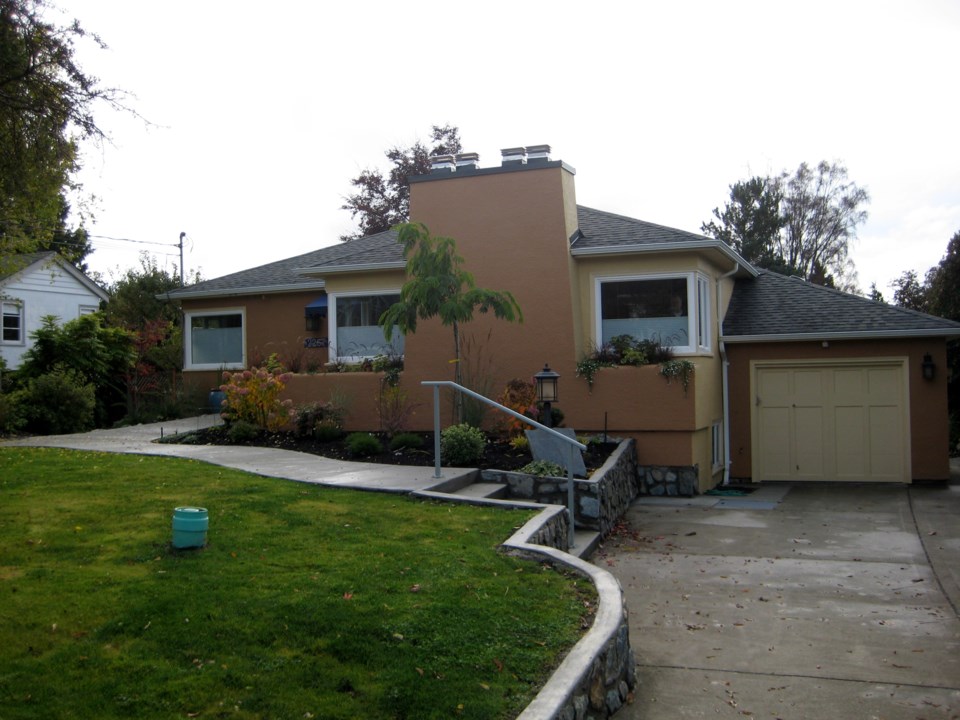 Different view shows new rock wall that follows the slope of the property up from the driveway to the house. The steps, now halfway up the driveway, used to start right next to the house, near the garage.
Different view shows new rock wall that follows the slope of the property up from the driveway to the house. The steps, now halfway up the driveway, used to start right next to the house, near the garage.
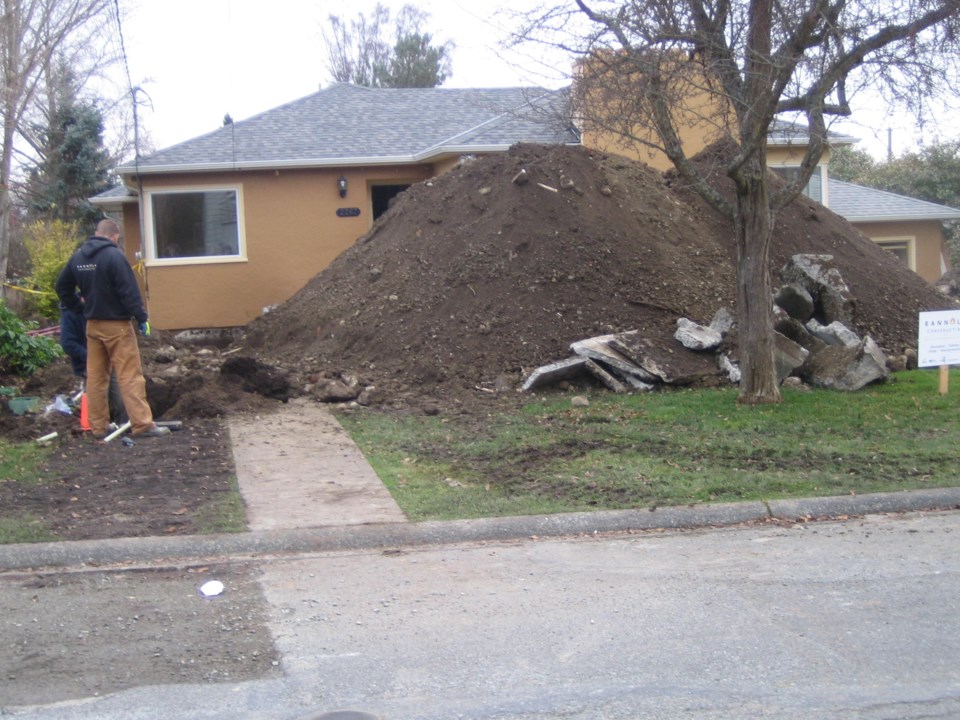 Yes, the place looked like a war zone during the foundation repairs.
Yes, the place looked like a war zone during the foundation repairs.
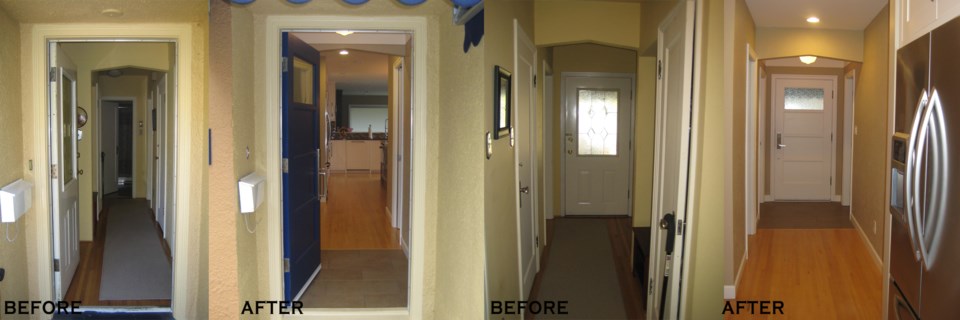 Before and after photos show the entryway, showing the view from the front door into the house on the left and from the kitchen toward the front door on the right.
Before and after photos show the entryway, showing the view from the front door into the house on the left and from the kitchen toward the front door on the right.
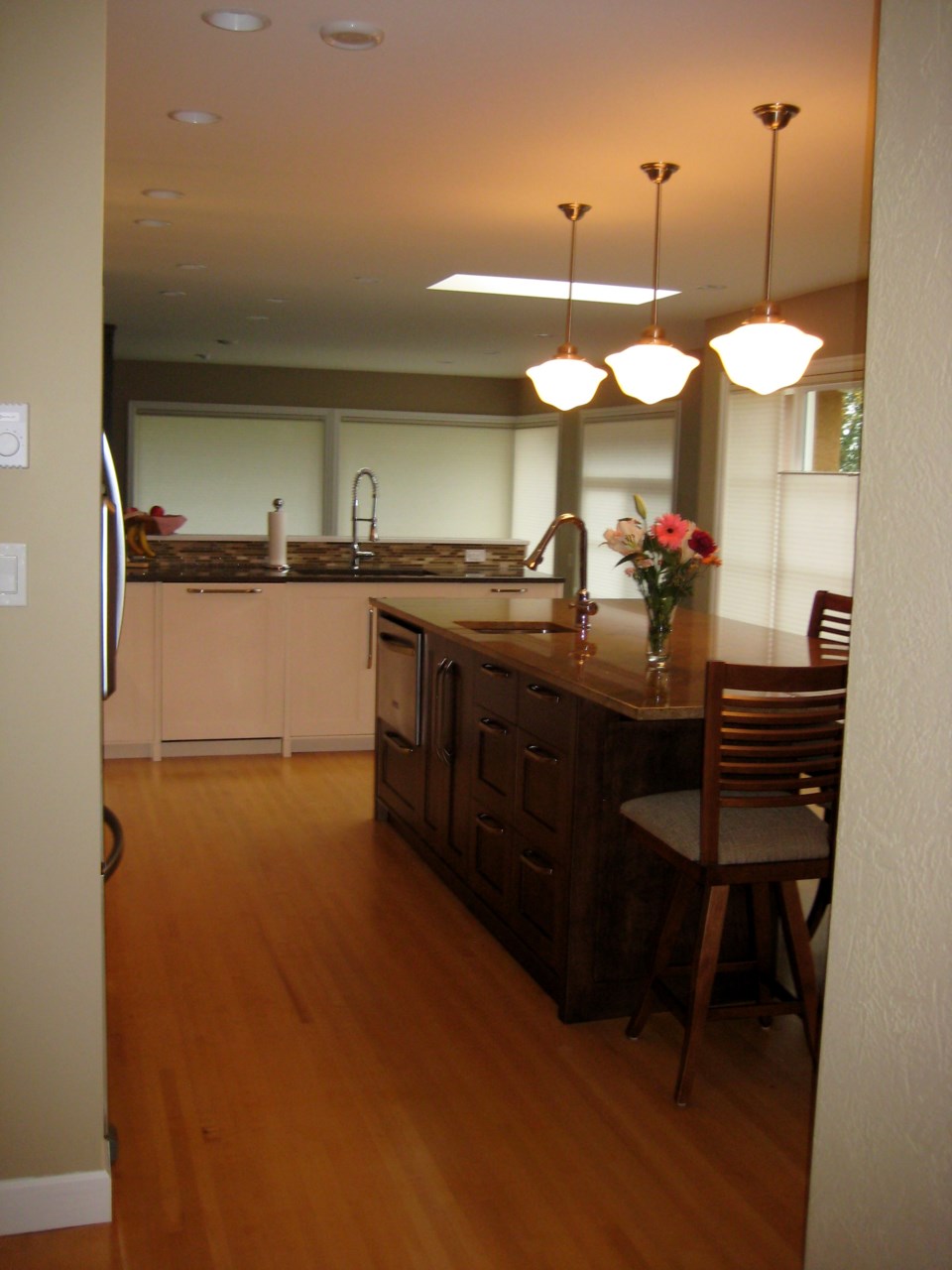 View from hallway into kitchen
View from hallway into kitchen
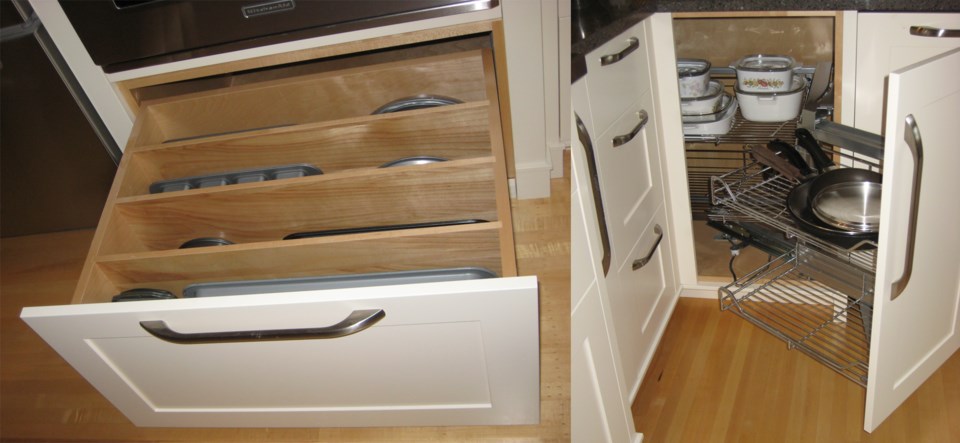 Among our favourite storage elements in the kitchen cupboards are the baking tray drawer, left, and the pullout corner shelving, right.
Among our favourite storage elements in the kitchen cupboards are the baking tray drawer, left, and the pullout corner shelving, right.
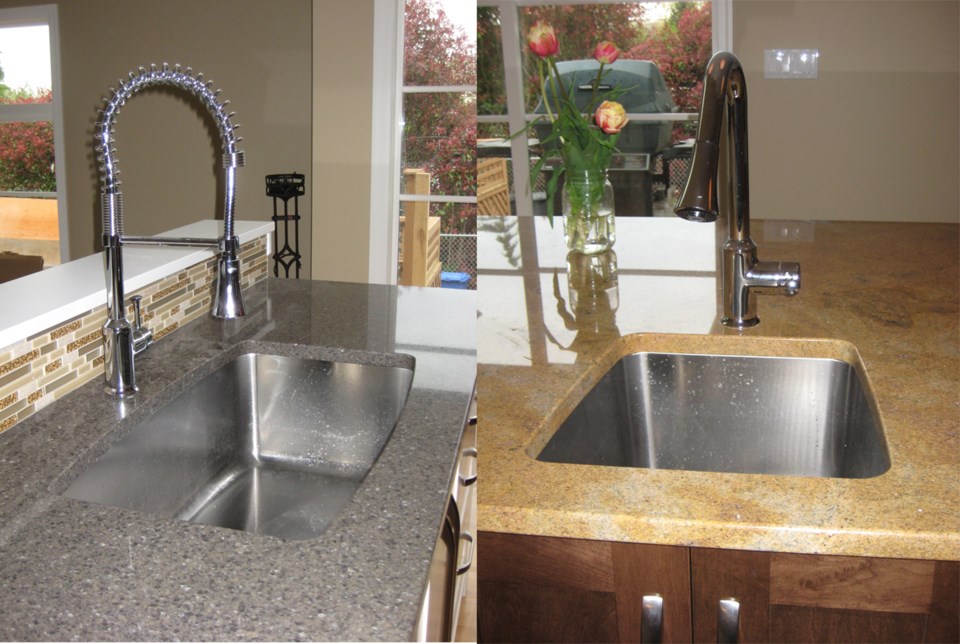 The kitchen features one large deep sink, left, and a smaller prep sink in the island, right.
The kitchen features one large deep sink, left, and a smaller prep sink in the island, right.
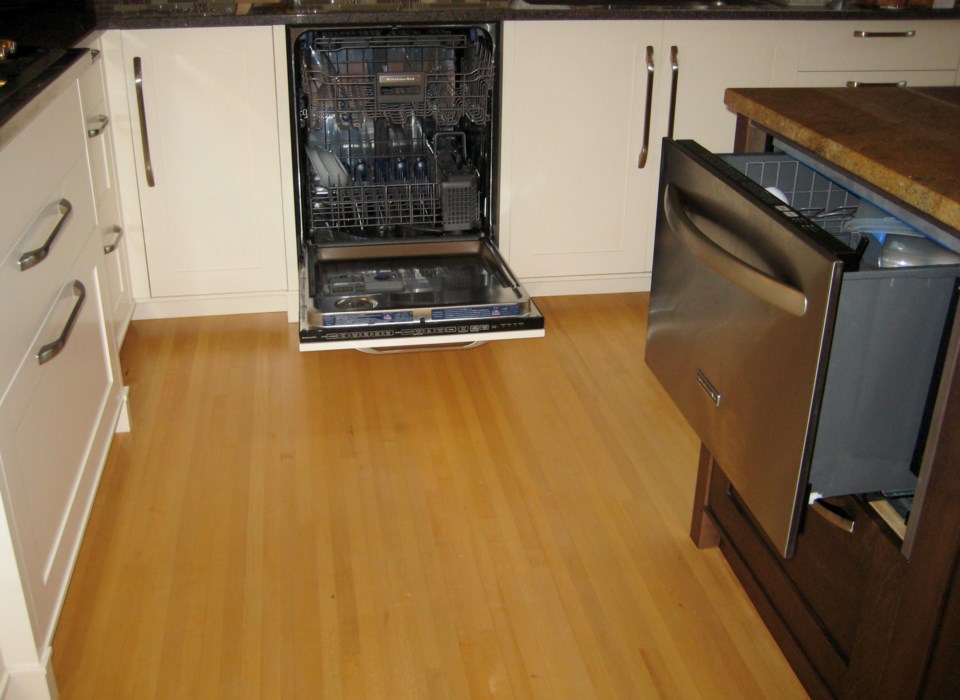 Two dishwashers -- one full regular size, left, and one smaller drawer version, right -- are, admittedly, an extravagance, but we're surprised at how often we manage to fill both an run them at the same time.
Two dishwashers -- one full regular size, left, and one smaller drawer version, right -- are, admittedly, an extravagance, but we're surprised at how often we manage to fill both an run them at the same time.
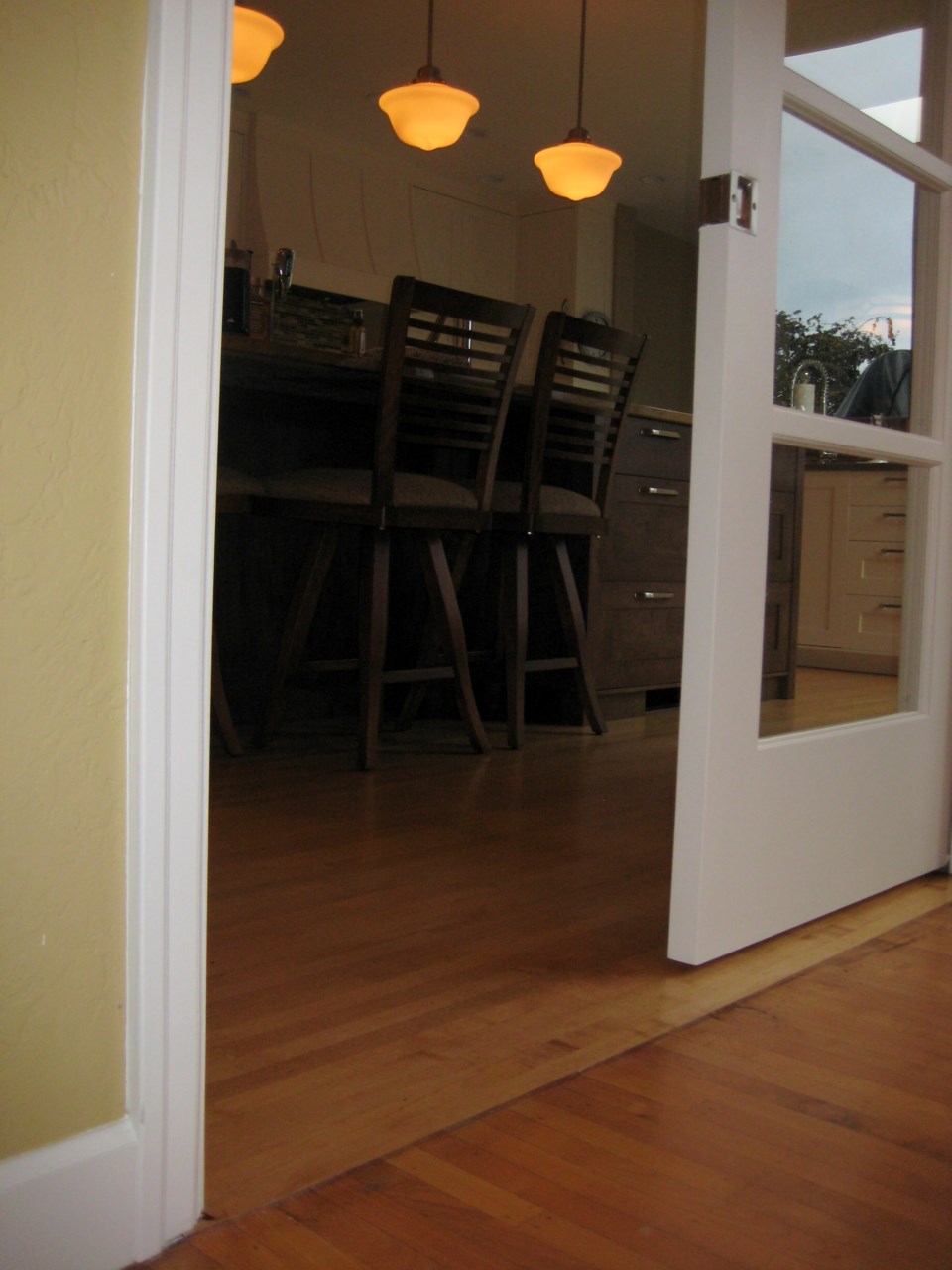 Thin-strip, top-nailed maple floors existed in the original part of the house, including the dining room, right. We had the same type of floor installed in the kitchen. It looks lighter now, but over time will darken to match the older floor.
Thin-strip, top-nailed maple floors existed in the original part of the house, including the dining room, right. We had the same type of floor installed in the kitchen. It looks lighter now, but over time will darken to match the older floor.
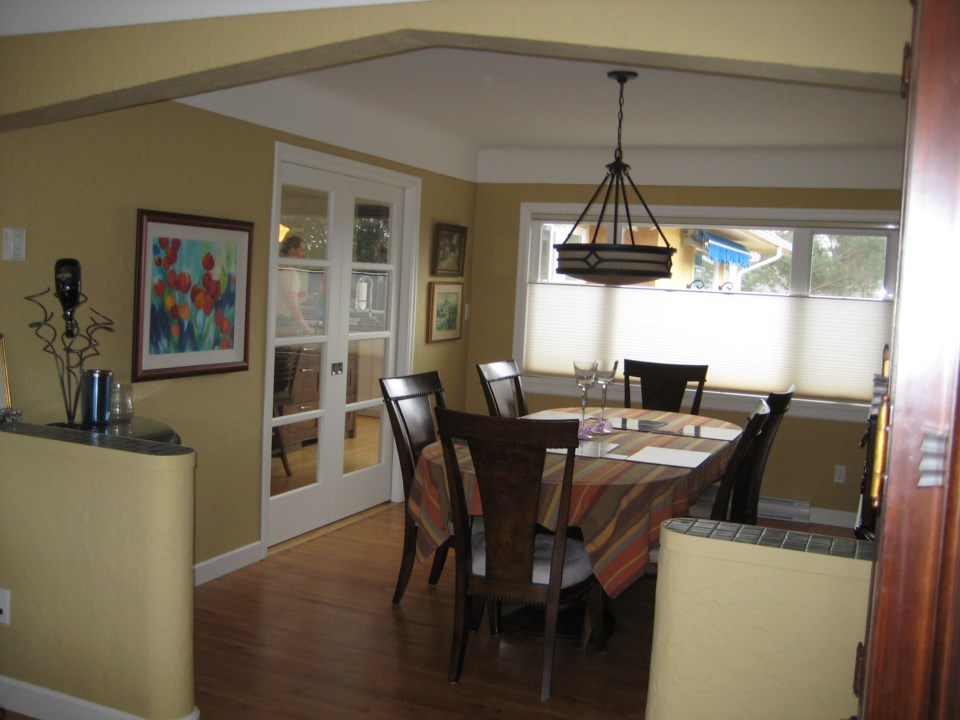 The original house had a small door from the dining room into the kitchen. We shifted the opening over and added pocket french doors between the kitchen and dining room. When we have a large gathering, we can tuck the doors into the walls so the two rooms seem like one large space.
The original house had a small door from the dining room into the kitchen. We shifted the opening over and added pocket french doors between the kitchen and dining room. When we have a large gathering, we can tuck the doors into the walls so the two rooms seem like one large space.
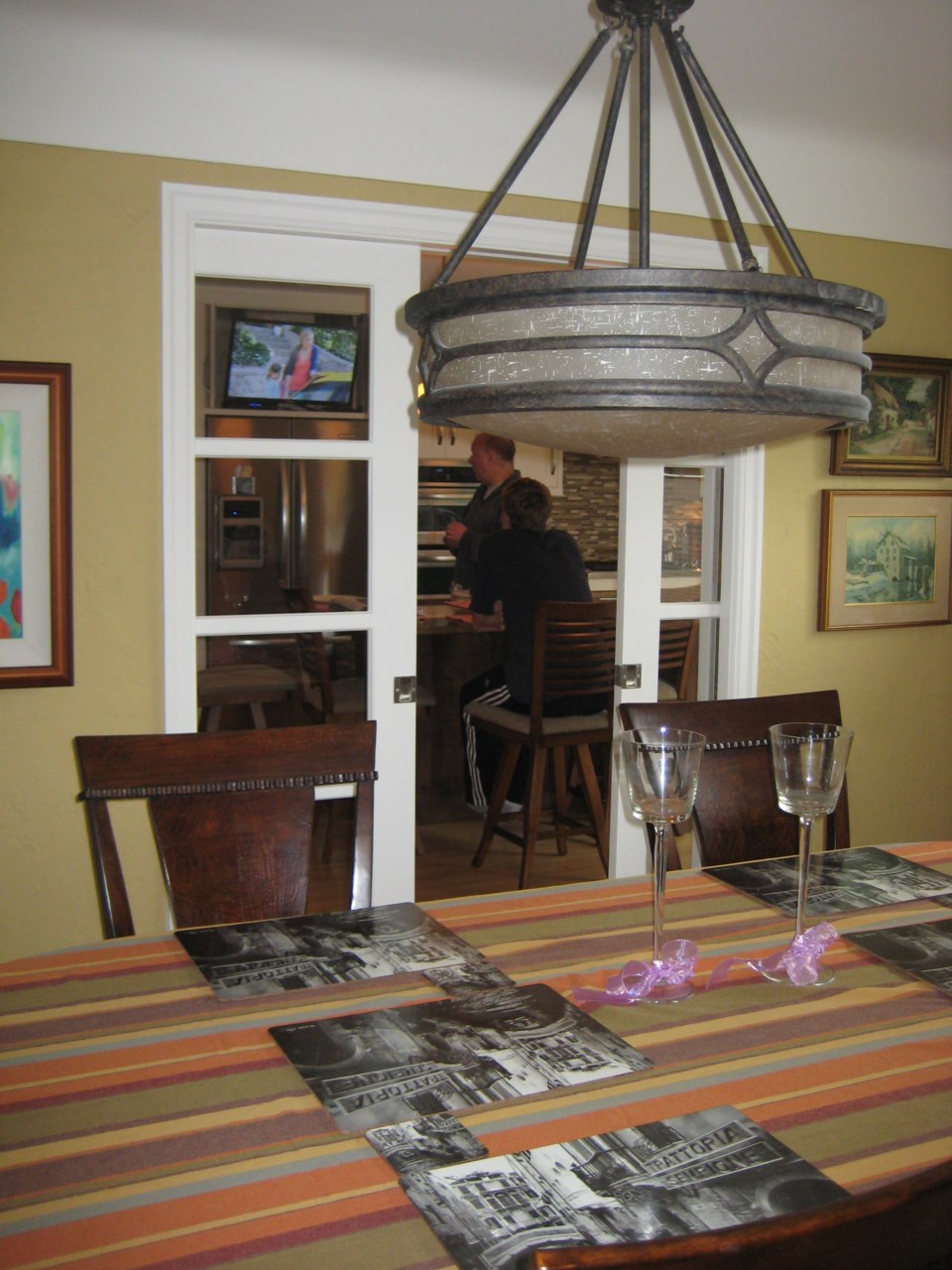 In the cupboard over the fridge in the kitchen, we tucked a flat-screen TV that can be pulled forward for viewing from the island in the kitchen or from the dining room -- which comes in handy for watching sporting events or election coverage.
In the cupboard over the fridge in the kitchen, we tucked a flat-screen TV that can be pulled forward for viewing from the island in the kitchen or from the dining room -- which comes in handy for watching sporting events or election coverage.
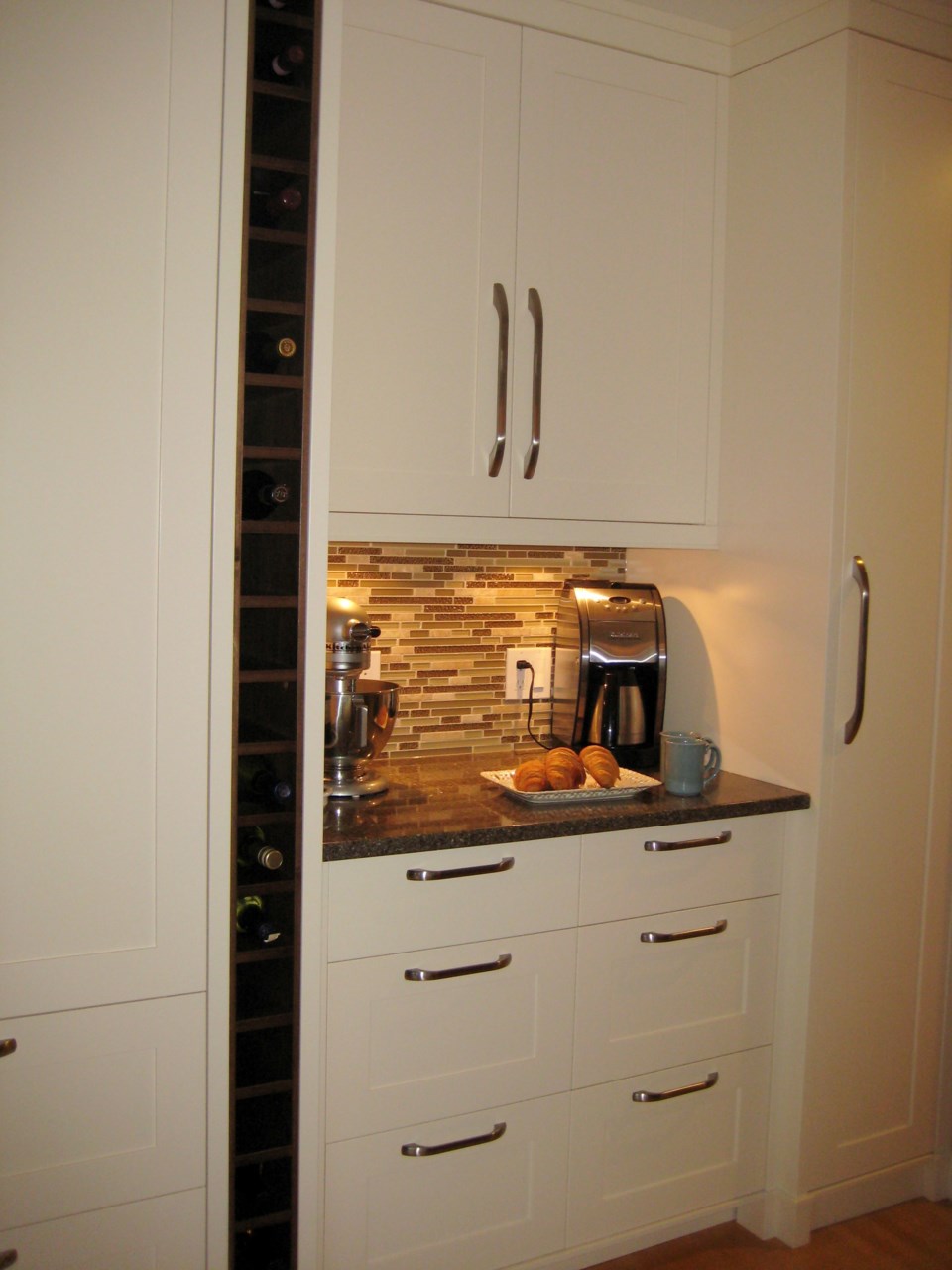 Coffee bar and wine rack in kitchen.
Coffee bar and wine rack in kitchen.
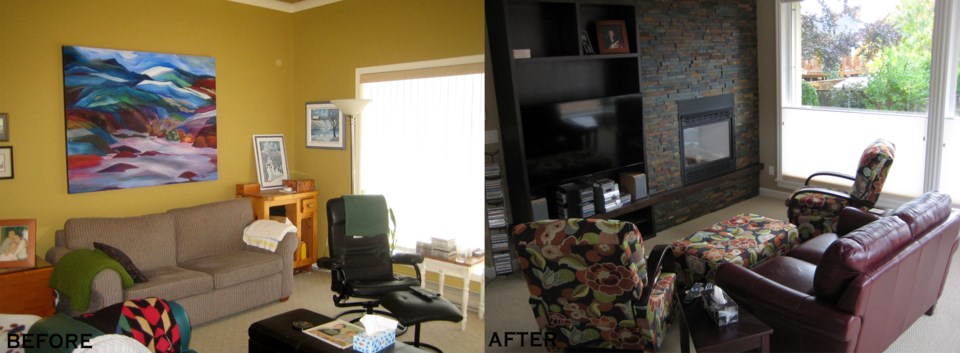 The wall between the family room and the master bedroom now features a wall unit with a large flat-screen TV and a two-way fireplace which warms both rooms.
The wall between the family room and the master bedroom now features a wall unit with a large flat-screen TV and a two-way fireplace which warms both rooms.
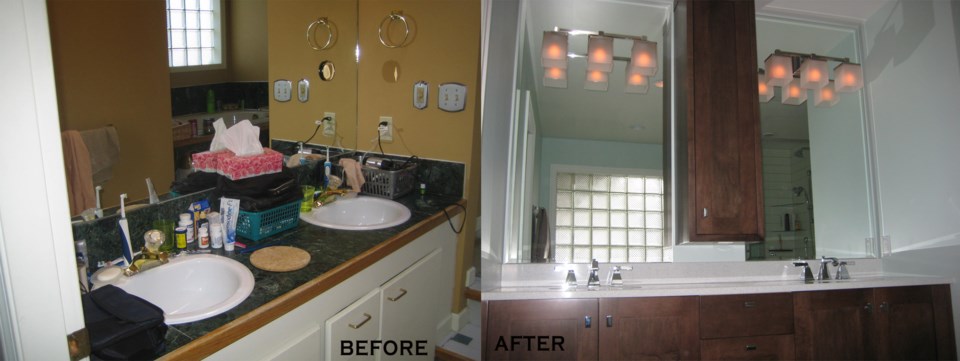 Master ensuite sinks, before and after the reno
Master ensuite sinks, before and after the reno
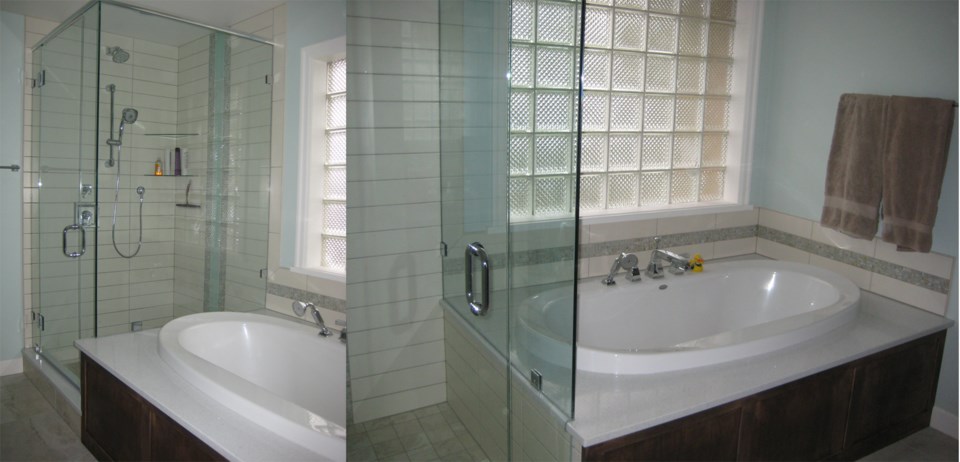 Shower stall and bath tub in ensuite. There was no point in replacing the existing glass block wall since it provided privacy in the bathroom.
Shower stall and bath tub in ensuite. There was no point in replacing the existing glass block wall since it provided privacy in the bathroom.
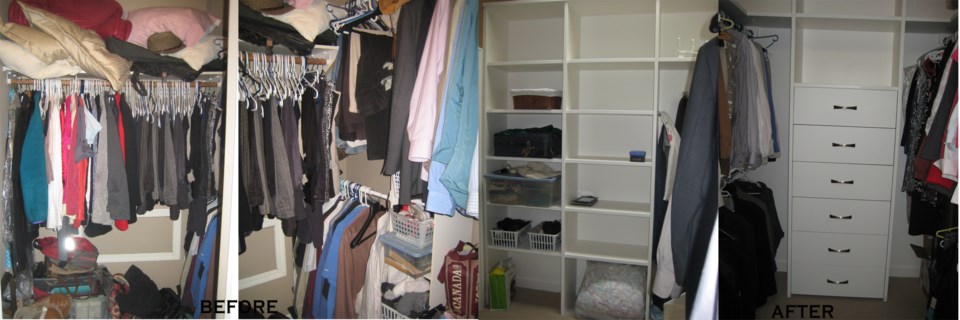 The original walk-in closet was small, crammed and awkward. The new closet -- filled with clothes hanging from the rods and baskets on the shelves since this photo was taken -- keeps everything organized and easy to find.
The original walk-in closet was small, crammed and awkward. The new closet -- filled with clothes hanging from the rods and baskets on the shelves since this photo was taken -- keeps everything organized and easy to find.
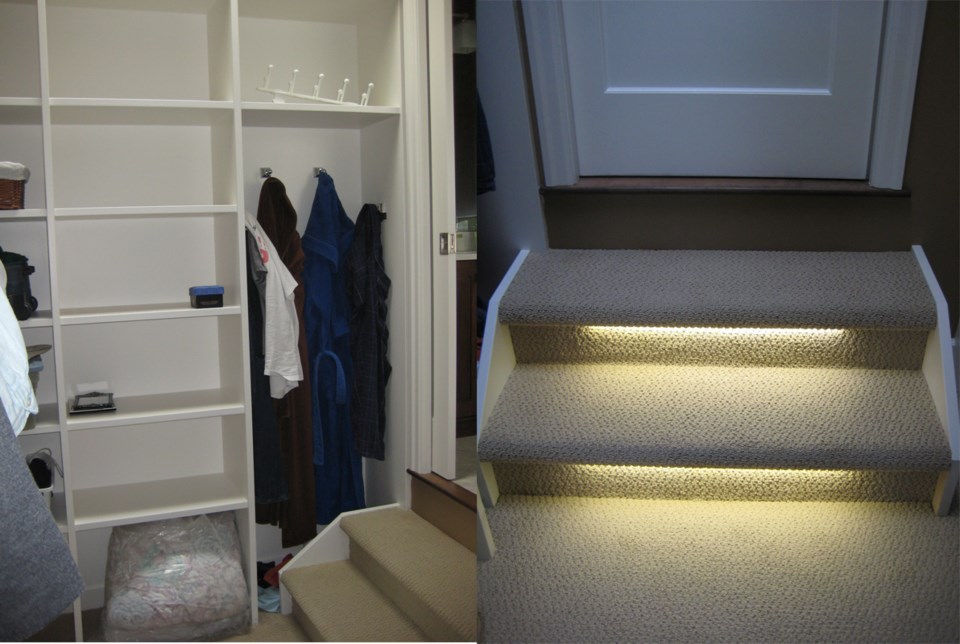 There are two steps up from our walk-in closet into our ensuite. Our electrician added a small string of lights that serve as nightlights.
There are two steps up from our walk-in closet into our ensuite. Our electrician added a small string of lights that serve as nightlights.
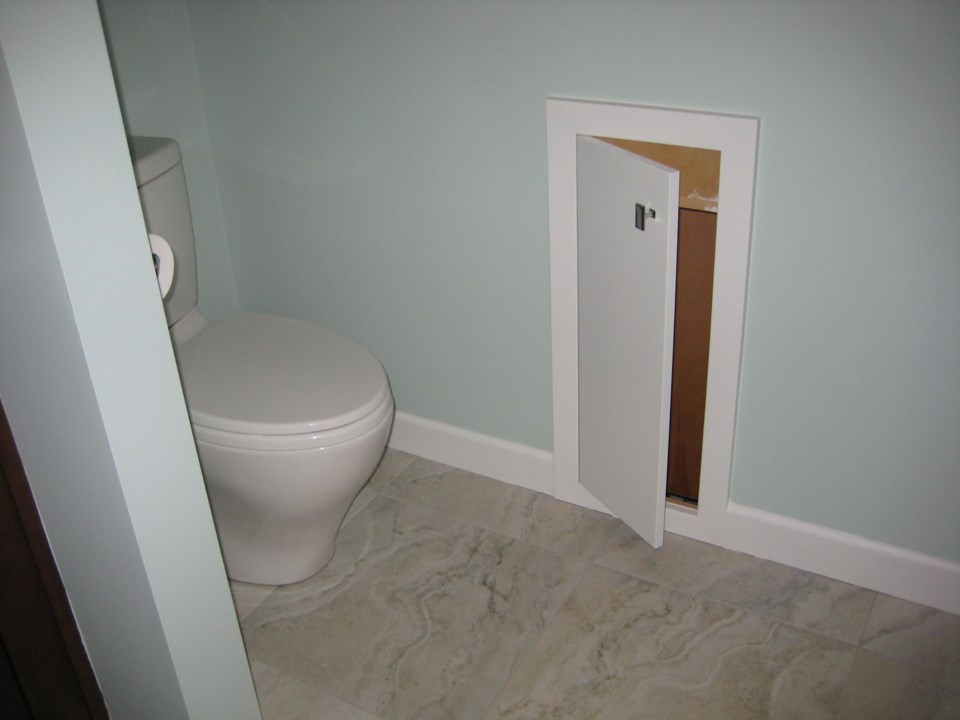 Small door in ensuite bathroom opens to the laudry chute.
Small door in ensuite bathroom opens to the laudry chute.
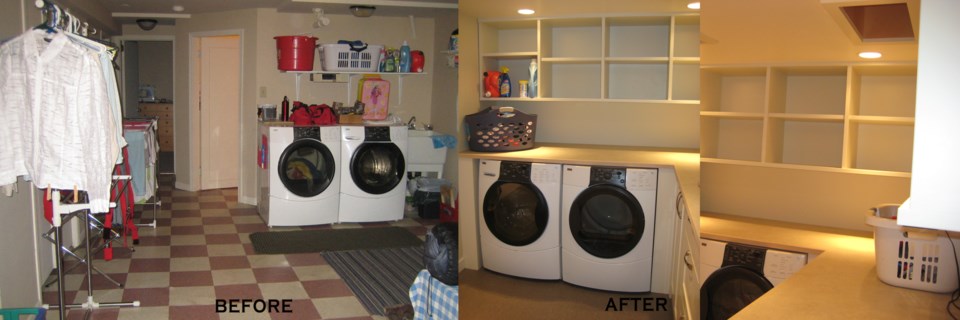 The old laundry sat in an open area in the basement. New laundry is a separate room which lots of counter space for folding, plenty of shelving, a deep sink (not shown in photo) and a laundry chute in the ceiling that connects to both bathrooms upstairs.
The old laundry sat in an open area in the basement. New laundry is a separate room which lots of counter space for folding, plenty of shelving, a deep sink (not shown in photo) and a laundry chute in the ceiling that connects to both bathrooms upstairs.
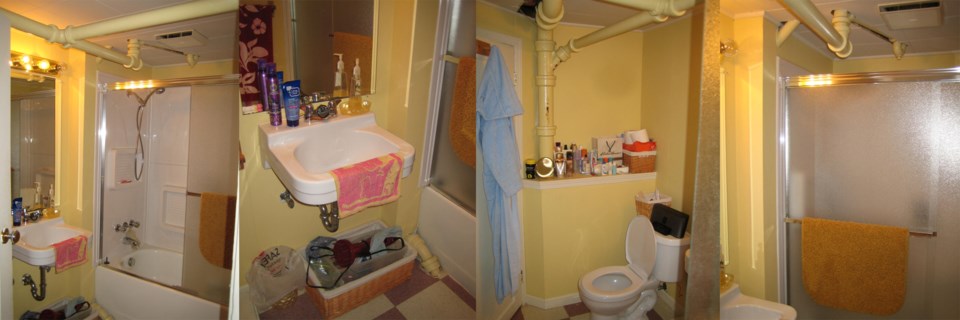 Undoubtedly the ugliest and most ill-conceived room in the house before the renovation was the downstairs bathroom, where pipes stuck out from the ceiling, the floor and the side wall. Anyone slightly taller than average height would have to duck to stand in there.
Undoubtedly the ugliest and most ill-conceived room in the house before the renovation was the downstairs bathroom, where pipes stuck out from the ceiling, the floor and the side wall. Anyone slightly taller than average height would have to duck to stand in there.
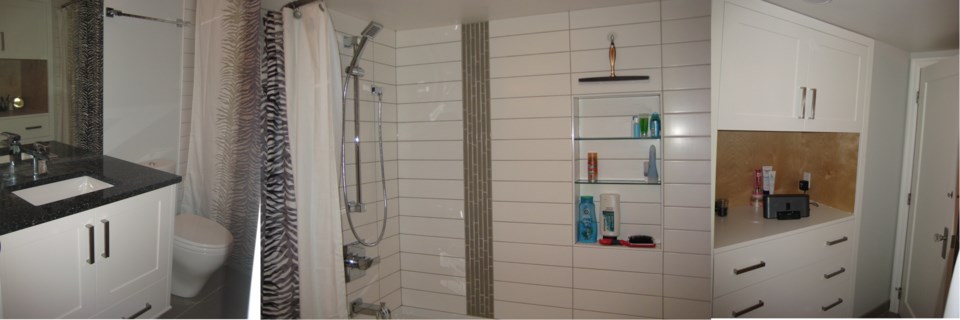 From left, the downstairs bathroom's vanity, bath/shower and built-in storage cupboard. The cupboard was a smart afterthought -- we decided to add it when we saw that it would be useful to steal a little space out of the adjacent storage room to add drawers where towels and linens could be stored for the downstairs bedroom.
From left, the downstairs bathroom's vanity, bath/shower and built-in storage cupboard. The cupboard was a smart afterthought -- we decided to add it when we saw that it would be useful to steal a little space out of the adjacent storage room to add drawers where towels and linens could be stored for the downstairs bedroom.
